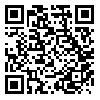Volume 22, Issue 4 (Winter 2019)
jwss 2019, 22(4): 317-329 |
Back to browse issues page
1. Department of Water Engineering, College of Agricultural, Arak University, Arak, Iran. , moghaddasi@araku.ac.ir
Abstract: (7126 Views)
Evaporation is one of the important components in water body’s management, leading to changes in the water level and water balance. Also, its accurate estimation is faced with certain difficulties and complexities. Because of the limitations of physical and empirical methods based on the meteorological data, remote sensing technology can be widely used for evaporation calculation due to its capabilities for spatial data estimation and minimization of the meteorological data application. Many models have been developed to estimate evapotranspiration using remote sensing technology. Regarding the use of these algorithms for estimating evaporation from water surface, a few studies have been done; however, there is yet no comparison between them to estimate evaporation from the water surface. For this purpose, in this study, the output from two models estimating spatially distributed evaporation of water surfaces from remotely sensed imagery is compared. In order to implement these models, Terra/MODIS Images for four months including June, July, August and September in of 2006, 2007, 2008 and 2009 were prepared. Comparisons were made using pan data from Urmia synoptic station. In general, there was a reasonable agreement between the evaporation outputs from both models versus a pan data observation. The statistical analysis also showed that the SEBS algorithm (by applying the salinity factor), despite being simple in its implementation, has higher accuracy than the SEBAL algorithm.
Type of Study: Research |
Subject:
Ggeneral
Received: 2017/09/2 | Accepted: 2018/04/18 | Published: 2019/03/15
Received: 2017/09/2 | Accepted: 2018/04/18 | Published: 2019/03/15
| Rights and permissions | |
 | This work is licensed under a Creative Commons Attribution-NonCommercial 4.0 International License. |




